|
The history of Chinese silk
According to archeological evidence, silk and silk fabric emerged in China at least 5,500 years ago. It was said that the demigod Leizu, a legendary figure of prehistoric China, who first planted mulberries and raised silkworms.
During the Zhou Dynasty (11th century-221BC), a special administration was set up to manage sericulture (silkworm breeding) and silk production. The famous Silk Road to the Middle East and Europe was opened in the western Han Dynasty (206BC-25AD). Gradually, sericulture and silk production techniques spread to other countries. Chinese silk was highly prized among the wealthy of the Ancient Roman Empire. Today, Chinese silk still enjoys high reputation for its superb quality throughout the world.
One circular life of silkworm
Silkworm has three distinct morphological stages: larva, pupa and moth. After hatching from the egg, actually the larva is not really a worm at all but a caterpillar. larvae go through four molts as they grow. During each molt, the old skin is exuviated and a new, larger one is produced. The silk worm larval life is divided into five instars, separated by four molts.
Sericulture
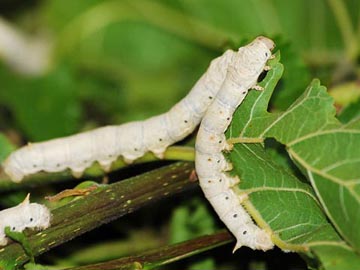 |
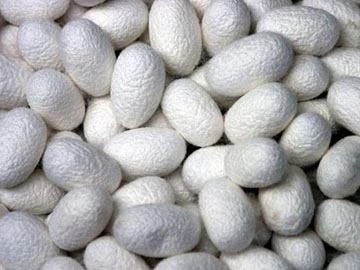 |
Silk
Worm |
Silk
Cocoon |
The egg of silkworm is very tiny as a pinhead. A female moth can lay 500 or more eggs in four to six days and dies soon after. The eggs must be kept at 65 degrees F, increasing gradually to 77 degrees at which point they hatch. The larvae hatch in about 10 days and the baby worms are about 0.6cm long. They eat day and night every half hour on fresh, hand-picked and chopped mulberry leaves until they are very fat. Also a fixed temperature has to be maintained throughout. Thousands of feeding worms are kept on trays. A roomful of munching of silkworms sounds like heavy rain falling on the roof. The newly hatched silkworm multiplies its weight 10,000 times within a month, changing color and shedding its whitish-gray skin several times.
The silkworms keep on eating until they
have stored up enough energy to enter the cocoon stage. At this time they
can be 7.5cm long. While they are growing they have to be protected from
loud noises, strong smells such as those of fish and meat and even the
odor of sweat. When it is time to build their cocoons, the worms produce
a jelly-like substance in their silk glands, which hardens when it comes
into contact with air. Silkworms spend three or four days spinning a cocoon
around themselves until they look like puffy, white balls.
After eight or nine days in a warm, dry place the cocoons are ready to
be unwound. Cocoons cannot be stored with a long time because the pupa
(chrysalis) remains alive it will begin to secrete alkali, which eats
its way through the cocoon, ruining the silk threads. So they are steamed
or baked to kill the pupas. The cocoons are then soaked into hot water
to loosen the tightly woven filaments. These filaments are unwound onto
a spool. Each cocoon is made up of a filament between 600 and 900 meters
long! Between five and eight of these super-fine filaments are combined
together to make one yarn. An interesting fact is that about 1,000 meters
of filament can be unwound from one cocoon, while 110 cocoons are needed
for a man's tie, and 630 cocoons are needed for a woman's blouse.
After the silk is harvested from the cocoons it is brought to the weavers
for dyeing and preparation for weaving. Today most dyes are chemical dye
but before it is vegetable dye.
Broken or waste filaments and damaged cocoons are retained, treated to
remove the sericin, and combed. This is then processed into yarn, marketed
as spun silk, which is inferior in character to the reeled product and
much cheaper. Low grade silk is made from damaged cocoons that were spoiled
by emerging moths used for breeding stock. Filaments from the coarse outer
portion of the cocoon, which is removed by brushing before reeling, and
the inner portion of the cocoon, which remains after reeling the raw silk,
are mixed with silk from damaged cocoons to make low grade silk.
Finally the silk threads are used for suits, coats, trousers, jackets,
shirts, handkerchiefs, ties, lingerie, hosiery, scarves, bedspreads, gloves,
lace, curtains, silk quilt, linings and handbags. They are also used for
embroidery work, and silk carpets.
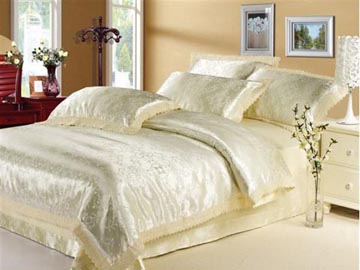 |
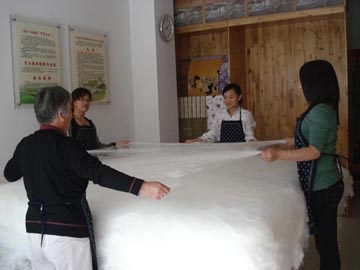 |
Silk
Bedding |
Making
Silk Quilt |
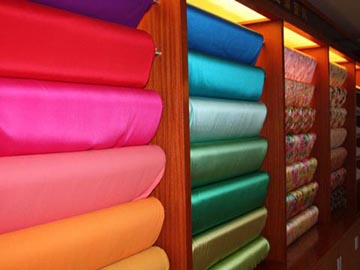 |
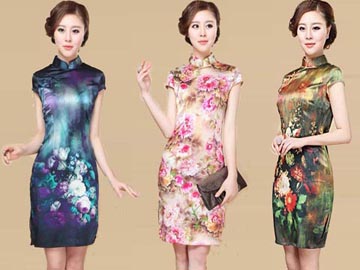 |
Silk
Fabric |
Woman Silk Dress |
Characteristics of silk
Silkworms possess a pair of specially modified salivary glands called
sericteries, which are used for the production of a clear, viscous, proteinaceous
fluid that is forced through openings called spinnerets on the mouthpart
of the larva. As the fluid comes into contact with the air it hardens.
The diameter of the spinneret determines the thickness of the silk thread,
which is produced as a long, continuous filament. Silk is a natural protein
fiber containing about 70-75% of actual fiber fibroin and about 25-30%
sericin. Silk filaments are very fine and long - as much as 300 to 900
meters in length. Silk has a high natural luster and sheen of a white
or cream color; and is one of the strongest fibers at 2.6 to 4.8 grams
per denier. When it is dry the elongation (elastic recovery) varies from
10-25% and when wet it will elongate as much as 33-35%. Silk has a relatively
high standard moisture regain of 11%. At saturation the regain is 25-35%.
Silk can be dyed before or after it has been woven into a cloth. It can
be woven or knitted.
Due to the quality of silk, the silk products are not only beautiful and
lightweight but also they are warm in cool weather and cool in hot weather.
At the same time silk products are moisture proof, germproof, antistatic
and anti-worms. So they are very good for health. Chinese silk products
are very welcomed by the people from all over the world.
Embroidery is an excellent traditional Chinese handicraft. The unearthed
silk painting and embroidery proved that its history was over 3000 years.
At present, the piece of embroidery of the Shang Dynasty (1600BC-1100BC)
found in Henan Province is the earliest embroidery handicraft in China.
The silk embroidery in ancient China had great influence
on the people’s material and cultural life. It was also the main article
for exporting via the Silk Road. During the Han Dynasty (206BC-220AD)
the technology of silk embroidery reached a fairly high level. In the
Qing Dynasty (1644-1911), the folk embroidery of different providences
with different styles mainly formed into four categories: Suxiu Embroidery
in Suzhou, Xiangxiu Embroidery in Hunan, Shuxiu Embroidery in Sichuan
and Yuexiu Embroidery in Guangdong.
After the People’s Republic of China was established, the
art of painting and photography has been applied on the silk embroidery
that created a terrific effect. They look like paintings from distance
but embroidery at close quarters. At the same time the usage of silk embroidery
was also expanded from the costumes to tablecloth, bedspread, pillowcases,
screens and wall hangings.
Embroidered works have become very complicated and exquisite today. The
double-sided embroidered cat is one representative work of suxiu Embroidery.
The artists split the hair-thin colored silk thread into filament, which
can be half, quarter, 1/8 or even 1/48 of its original thickness. They
use these very thin filaments in embroidering. But the thousands of ends
and joints cannot be seen just like disappearing. The finished work is
a cute and lovely looking cat on both sides of the groundwork. The most
difficult part of the work is the eyes of the cat. In order to give them
luster and life, silk filaments of more than twenty colors of shade have
to be used. Recently the double-sided silk embroidery has developed further
innovations. The same design on both sides is embroidered in different
colors and totally different designs on both sides can be embroidered
on the same groundwork. That is really incredible artwork.
The four famous categories of silk embroidery represent
the artistic value and workmanship of Chinese embroidery.
Suxiu Embroidery is known for its neat stitches, elegant colors and fine
quality. Smooth, neat, bright, even, fine and tight are its feature. The
subjects of its embroidering are mostly cats, finish and shrimps. The
double-sided Suxiu Embroidery with two sides that can be appreciated is
really exquisite.
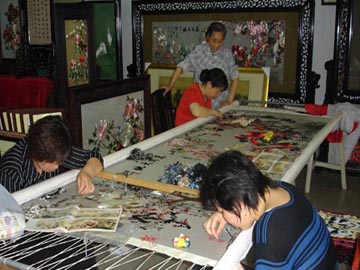 |
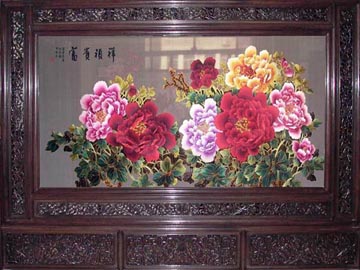 |
Making
Embriodery |
Peony
Screen Embriodery |
Xiangxiu Embroidery has bright colors.
It always uses Chinese paintings as its background. The mountains, rivers,
pavilions, birds and animals are embroidered realistically and lifelike.
The techniques of Xiangxiu Embroidery are manifested fully in the embroidery
of tigers and lions. Their hair is embroidered with fine lines. There
is a saying: On Xiangxiu Embroidery tiger can run, bird can sing, flowers
are fragrant and people are lifelike.
Shuxiu Embroidery is characterized by its simple structure, bright colors,
well-knit stitches, smooth surface and traditional decorator designs such
as squares and stripes. Its subjects are mostly butterflies, carps, pandas
and so on.
Yuexiu Embroidery is always done with gold or silver threads, which are
neat and bright. It has tight layout, decorator designs and gorgeous surface.
It is mostly used in theatrical costumes and wedding gowns.
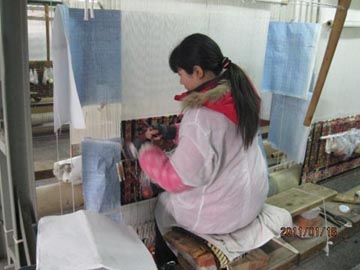 |
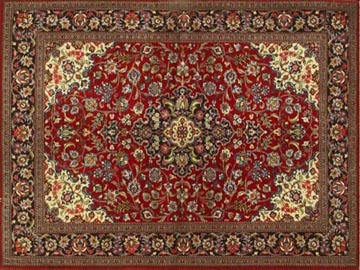 |
Making
Silk carpet |
Oriental
Silk Carpet |
Peacocks, dragon, phoenix are its traditional
subjects.
Chinese Silk carpets
Chinese carpets have centuries-old history
and enjoy a great reputation. Assimilating the essence of Persian carpets,
the skillful Chinese craftsmen improved the workmanship to the peak of
perfection and they knotted very refined Persian design pure silk carpets
which can match or exceed the Iranian Qum silk rugs in quality and workmanship.
Due to the high quality and competitive price Chinese Persian design silk
rugs are welcomed in the high-end market. However this handicraft industry
is declining in output in the new century because the weavers switch to
other jobs instead of knotting rugs. So the high quality Chinese silk
rugs will disappear soon and absolutely the value will increase a lot
with the passing of time.
If
you have interest in Chinese silk rugs please go to this web site to learn
more detailed information.
www.chinasilkcarpet.com
Mobile:(+86-1350
110 3837) Wechat:(13501103837) E-mail: chinasilkrug@msn.com